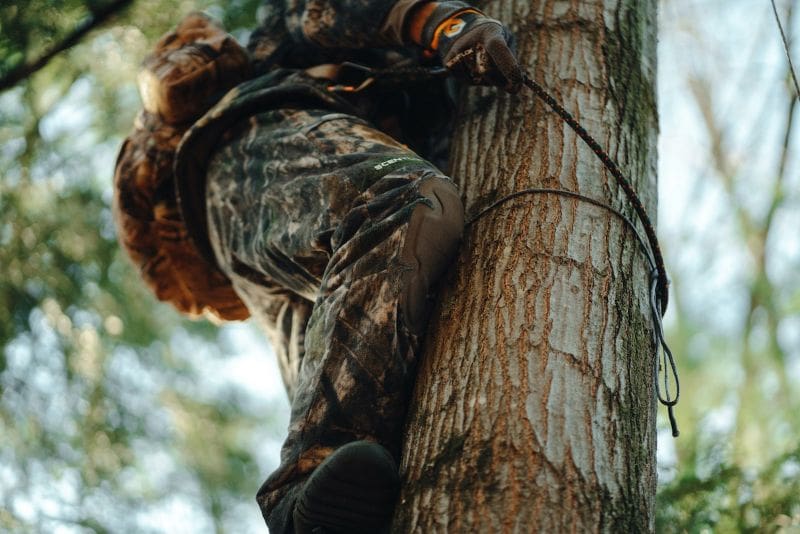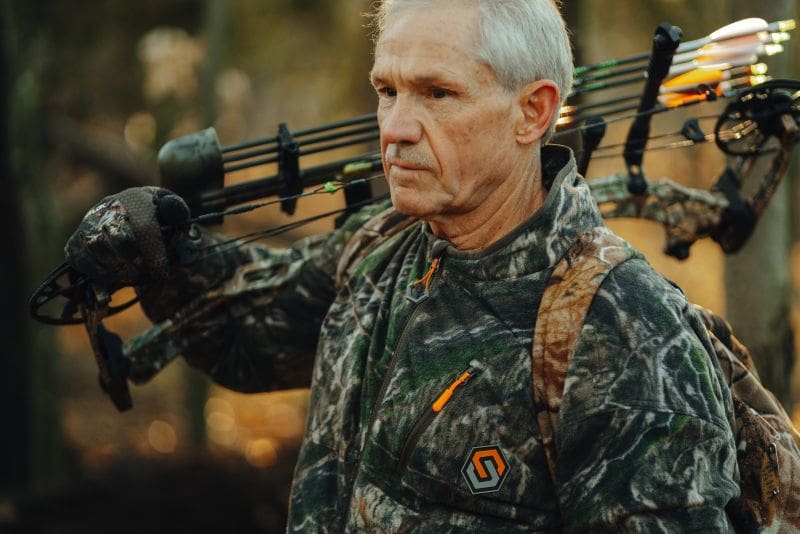ScentLok advocate and legendary whitetail deer hunter John Eberhart discusses the gear that makes him such a formidable saddle hunter and master of hunting public spaces
Deer season is well underway across the country, and while some lucky hunters have already punched a tag or two, many have delayed their first sit due to unusually warm weather. Regardless, it is most certainly that time of year when the hunter’s soul stirs as days get shorter and the leaves begin to change.
While many hunters are invested in deer hunting year-round, others are encumbered by life’s other responsibilities and roll with the punches from season to season. Luckily, it’s never too late to make an adjustment in your method of operation and rethink how and where you hunt. A change of scenery and a new way of hunting may be just what is needed to kick-start your annual deer hunting odyssey.

John Eberhart knows a thing or two about bucking (pun intended) conventional wisdom when it comes to deer hunting. Eberhart specializes in saddle hunting public land whitetails and has nearly 60 years of deer hunting experience under his belt. His accolades include 36 bucks listed in the Commemorative Bucks of Michigan record book and 21 P&Y class bucks. Eberhart has never owned, leased, or paid a dime to hunt anywhere, opting to exclusively hunt public, free walk-on, and knock-on-doors for free permission properties whether in Michigan or out of state. So, we decided to pick his brain about saddle hunting gear.

Question: How do you typically dress for a hunt?
Eberhart: For starters, I always wear ScentLok pants and jacket 100% of the time when I’m entering and exiting, because I may brush against vegetation and don’t want to leave any odor. It’s important to learn how to dress so you don’t overheat during entry, but while staying comfortable on stand all day – it’s an art form really.
When I was younger, I would wear all my clothes and layers on entry, but I’d sweat my ass off and my bottom layer would be damp. I’d end up getting cold quicker because of the dampness.
I learned how to keep all my layers in my backpack and add or remove layers in the tree as many as three or even four times a day if it was an all-day sit. I put on super light clothes for entry, especially if it’s a long hike, so I don’t overheat. My layering garments are in my backpack, and I’ll pack them in the order that makes the process easier when I remove them. Once I get up the tree, I take off my jacket, lay it over a branch, and once my body cools off a little bit, I’ll put on my layering garments and jacket back on as well. When it warms up midday, I’ll take a mid-layer off but put the jacket back on again and remain that way until it cools off again during late afternoon. Eventually I’ll put my mid-layer back on under my jacket. When leaving I’ll do the reverse again, so I don’t get sweaty on the way out.
Question: What is your favorite base layer?
Eberhart: Merino wool such as the ScentLok Merino 250 Hoodie or Merino 1/4 Zip and sometimes with the BE:1 Reactor Puffy Heated Vest. I like the merino layer against my body – you feel the heat, and again, I’m trying to mitigate sweat. Our bottom halves don’t perspire like the upper body does and your body temperature is mostly dictated by your upper body core. So, legs are rarely an issue, but I still wear a Merino Base Bottom. That said, if it’s colder out, I’ll wear a heavier base on my bottom with my pants over top.
Question: How about your head, do you wear anything?
Eberhart: My head never really gets that cold but when it gets a little cooler out, you know, like late October or November, I wear the ScentLok head cover, which is enough to keep my head warmer.
Question: You are known for hunting with a saddle on public land and you’ve tagged an insane number of trophy white-tailed deer – what is your favorite saddle?Eberhart: In my opinion there’s nothing more comfortable than a two-panel saddle. Single panel saddles tend to ride up all the time. So, for example, when you fidget around a little bit or change your position, about every 10 or 15 minutes you must adjust by lifting up your weight to pull the seat back under your butt. You don’t have to do that with a two-panel style because the panels work independently and stay put. Also, with a two panel, you can adjust for more support on your lower back if needed, whereas with a single panel you cannot adjust independently.
Question: Are there any widgets or gear you consider “must haves” for saddle hunting?
Eberhart: The safety rope is called the lineman’s rope, and you use it while climbing and descending the tree, whereas the tether rope is used once you’re hunting. On the tether, the prusik knot is what your carabiner is attached to, and this knot slides up and down the tether rope, so it’s adjustable.
I replace the prusik knot with a Rope Man Ascender. It’s been around a long time; rock climbers and tree trimmers use it for ascending and descending. A lot of times when you sit in the saddle, especially if you’re a heavier guy, the prusik knot gets very tight and it’s difficult to loosen when you need it to move up and down the tether. On the other hand, the Rope Man Ascender allows you to make quick adjustments for when you’re taking a shot and need to move a few inches around the tree. And it only takes a half a second to make an adjustment, whereas the prusik may take five seconds or more to adjust.
I think a lot of guys are intimidated by saddle hunting, you know, and this style of adjuster is one way to make things less intimidating and comfortable. If you’re going to change one thing, replacing the prusik with a Rope Man Ascender would by my number one recommendation.

Question: What types of mapping do you use when scouting a given parcel for good locations to hunt?Eberhart: I use onX often, but if I want a bigger picture, I’ll use Google Earth when I’m scouting public land from an aerial view. I do love onX because you may find some great looking spots. And sure, until you go there and look at it, you have no idea how much hunting pressure is occurring on the property and how it’s impacted the spot. You have no control of that, but it narrows down where you need to scout.
Eberhart: Perfect pinch points or a transition corridor between two big areas of timber, and it might be divided by crop fields on each side, transitions between bedding-areas and feeding-locations, islands in swamps where you might have to wear waders to access , which can eliminate a huge percentage of competition – plus those are the places pressured deer head to. Ideally, the image includes topo elevations as well, so you can see elevations on a ridgetop or whatever. If you find a stand of oaks on a ridge and it’s difficult to get to, you can separate yourself from other hunters.
Question: Speaking of oaks, if you had to choose between white oak and red oak or other trees, which would you prefer?
Eberhart: Well, that’s a no-brainer there – obviously it’s going to be white oak because they have far-less bitter tannins and are more palatable to deer. When you’re in an area with oaks there are typically lots of them, so deer can feed on oaks pretty much at will, but if I had other options, I’d choose apple trees over oak trees for example. It’s very rare to find a pear tree, but pear trees would be number one.
Apple trees are number two, and they are more common. A lot of public land used to be pasture back in the 40s and 50s and cows spread apple trees with digested apple seeds. There are apple trees all over the place on some public lands. And deer do love chestnuts, but unfortunately, they’ve become rare, too. Chestnuts are a great alternative food source as well. For more insights into hunting public land whitetails and other deer hunting related information – including Eberhart’s latest book Ultimate Guide to DIY Bucks, check out www.deer-john.net.

